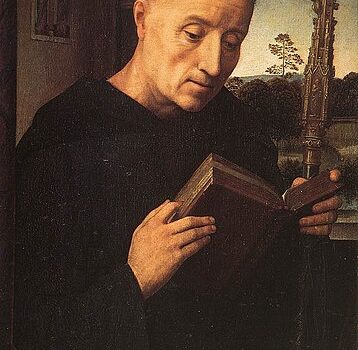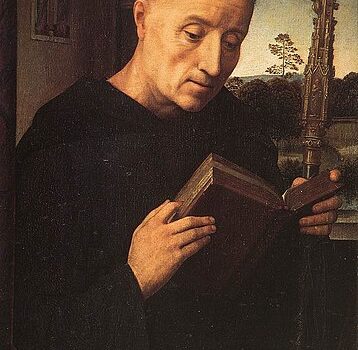
 The founder of the Benedictine Order, St. Benedict (ca. 480-547) came from a distinguished Italian family (his sister was St. Scholastica). He studied in Rome as a young man, but disturbed by the city’s sinful and chaotic nature, he chose to live as a hermit at the age of twenty. Soon afterward some monks asked Benedict to be their leader; though this initial experiment failed (as the monks were upset by Benedict’s high standards, and even tried to poison him), the saint was enthusiastic over the idea of monasticism: hermits or monks living together in a community, combining contemplation, work, and shared prayer.
The founder of the Benedictine Order, St. Benedict (ca. 480-547) came from a distinguished Italian family (his sister was St. Scholastica). He studied in Rome as a young man, but disturbed by the city’s sinful and chaotic nature, he chose to live as a hermit at the age of twenty. Soon afterward some monks asked Benedict to be their leader; though this initial experiment failed (as the monks were upset by Benedict’s high standards, and even tried to poison him), the saint was enthusiastic over the idea of monasticism: hermits or monks living together in a community, combining contemplation, work, and shared prayer.
Benedict organized twelve small communities, and in 529 established the famous monastery of Monte Cassino (with his sister establishing a religious community for women nearby). The Benedictine Rule emphasizes ora et labora (“pray and work”); under Benedict’s version of monastic life, a religious community devoted itself to prayer, study, and manual labor, living together under the leadership of an abbot. Benedict’s rule is characterized by moderation (unlike some early Christian movements, which stressed severe acts of self-discipline), and Benedict himself, in spite of his high standards, was a gentle and peaceable man. The saint performed many miracles, and when he died, he was buried in the same grave as his sister St. Scholastica. The monasteries established under his influence played a vital role in preserving learning and culture during the Dark Ages, and the Rule of Benedict has guided many monks and religious up to the present day.
Other Saints We Remember Today
St. Pius I (167), Pope and Martyr
photo by Hans Memling via Wikimedia Commons










